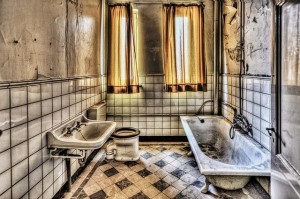Bathroom water damage is one of the worst situations you can find yourself it. It can cost you thousands if you leave it untreated. A little water can cause serious damage to walls, flooring and paint.
These are a few subtle signs that you could use to determine whether you need to hire a plumber to fix any leaks before things get out of hand.
Mildew or mold
You can clean your bathroom as much as you like but mildew or mold can spring up if you have a hidden water leak. Mold thrives on moist, dark areas. A pipe hidden in a wall or under flooring provides the perfect breeding ground for mold or mildew if it springs a like.
It is normal for a little mildew to occur whenever water accumulates, like in the corner of a shower. Mold or mildew that is on non-shower walls or in corners of the bathroom is a clear indication that water is leaking somewhere and finding its way to those areas. A leaking pipe provides plenty of moisture, so the longer it takes for you to find and repair the leak, the easier and faster mold will grow.
Damaged paint or wallpaper
A wall with blistering paint or wallpaper is another sign of bathroom leaks.
In most cases, steam from the occasional hit shower should not cause paint or wallpaper to come loose. When water and moisture gets lodged between the wall and paint, they eliminate the bond and begin to separate the two. It causes the paint to rise from the wall and fall off in pieces. The same goes for wallpaper. The adhesive use to bond the wallpaper to the wall becomes less sticky and the paper begins to peel away from the wall.
Damaged Walls
A wall that is warped or stained for no reason is a clear sign that you have a plumbing leak in your bathroom.
When drywall is exposed to moisture, it becomes soft and begins to bubble. Later on it ultimately warps and breaks into pieces. If the leak reaches the ceiling, it causes the ceiling to sag and possible leak some of the water that has accumulated.
In order to fix this leak, a plumber usually tears out the drywall and requires someone to patch and paint when the plumber is finished.
A bathroom floor rarely suffers water damage unless you purposely let water sit on it or there is a leak. If your bathroom floor is buckling, cracking or beginning to stay for no apparent reason, chances are that hidden water is to blame. The water could be from a pipe directly under the floor, or it could have moved there from another area.
Stained ceilings
If you have a bathroom on a second floor, you might spot a leak in the ceiling under the bathroom. Check the patch of ceiling in the room directly beneath the bathroom for stains and signs of water damage. It is also possible to find water stains on the ceiling further away because water can travel a long distance.
An occasional wet floor in a second-story bathroom will not cause enough seepage to damage anything underneath it. Any brown, copper or dark stain on the ceiling is a sign that a water leak is present in the ceiling. A sagging ceiling is a sign that water from a leak is reaching the area.
Smelly old water
Old, accumulated water from a leaky pipe can cause quite a stench.
If you still notice a musty or earthy smell after thoroughly cleaning your bathroom, it is very likely that you have hidden leaks. Hidden water never has a chance to dry.
If you suspect that you have any leaks or water damage, you need to contact a qualified plumber immediately.



